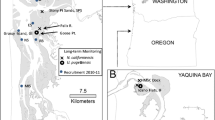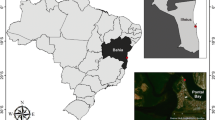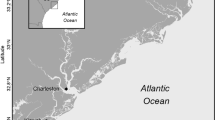Synopsis
Mbuna are species of small cichlids that inhabit the rocky shoreline of Lake Malawi. They are mouthbrooders and do not guard their young. Recruitment to the community first occurs when the female deposits free-swimming young, approximately 11 mm standard length, among the rocks. Juvenile mbuna recruit to any refuge in the rock habitat and in this study, small rock shelters were monitored daily to follow the recruitment and subsequent persistence of young. Initial mortality rate was high; less than 10% of the fish survived more than 3 weeks after deposition by the female. At the two locations studied, recruitment was greater at West Thumbi Island (11 fish per day) than at Otter Point (8 fish per day). However, fewer recruits persisted as residents at Thumbi Island because mbuna young at Thumbi were capable of excluding subsequent recruits to their shelter. Similar priority effects were not observed at Otter Point. Mbuna lack pelagic stages in the life-cycle and the species composition of local adult assemblages is an important determinant of the number and type of subsequent recruits. Priority effects may help maintain stochastic influences on recruitment success and reduce the importance of deterministic processes that are directly linked to community structure.
Similar content being viewed by others
References cited
Balon, E.K., 1977. Early ontogeny ofLabeotropheus Ahl,1927 (Mbuna, Cichlidae, Lake Malawi), with a discussion on advanced protective styles in fish reproduction and development. Env. Biol. Fish. 2: 147–176.
Barlow, G.W. 1981. Patterns of parental investment, dispersal and size among coral-reef fishes. Env. Biol. Fish. 6: 65–85.
Brock, R.E., C. Lewis & R.C. Wass. 1979. Stability and structure of a fish community on a coral patch reef in Hawaii. Mar. Biol. 54: 281–292.
Connell, J.H. & R.O. Slatyer. 1977. Mechanisms of succession in natural communities and their role in community stability and organization. Amer. Nat. 111: 1119–1144.
Doherty, P.J., D.McB. Williams & P.F. Sale. 1985. The adaptive significance of larval dispersal in coral reef fishes. Env. Biol. Fish. 12: 81–90.
Ehrlich P.R. 1975. The population biology of coral reef fishes. Ann. Rev. Ecol. Sys. 6: 211–247.
Fryer, G. 1959. The trophic interrelationships and ecology of some littoral communities in Lake Nyasa with especial reference to the fishes, and a discussion of the evolution of a group of rock-frequenting Cichlidae. Proc. Zool. Soc. Lond. 132: 153–281.
Fryer, G. 1977. Evolution of species-flocks of cichlid fishes in African Lakes. Z. Zool. Syst. Evolutionsforsch. 15: 141–165.
Fryer, G. & T.D. Iles. 1972. The cichlid fishes of the Great Lakes of Africa. Their biology and evolution. Oliver & Boyd, Edinburgh. 641 pp.
Gascon, D. & R.A. Miller. 1981. Colonization by nearshore fish on small artifical in Barkley Sound, British Columbia. Can. J. Zool. 59: 1635–1646.
Greenwood, P.H. 1974. The cichlid fishes of Lake Victoria, East Africa: the biology and evolution of a species-flock. Bull. Br. Mus. (Nat. Hist.) Zool. Suppl. 6: 1–134.
Greenwood, P.H. 1984. African cichlids and evolutionary theories. pp. 61–74. In: A.A. Echelle & I. Kornfield (ed.) Evolution of Fish Species Flocks, University of Maine at Orono Press, Orono.
Helfman, G.S. 1978. Patterns of community structure in fishes: summary and overview. Env. Biol. Fish. 3: 129–148.
Hobson, E.S. 1972. Activity of Hawaiian reef fishes during the evening and morning transitions between daylight and darkness. U.S. Fish. Bull. 70: 715–740.
Hori, M., K. Yamaoka & K. Takamura. 1983. Abundance and micro-distribution of cichlid fishes on a rocky shore of Lake Tanganyika. Afr. Study. Monogr. 3: 25–38.
Johannes, R.E. 1978. Reproductive strategies of coastal marine fishes in the tropics. Env. Biol. Fish. 3: 65–84.
Kock, R.L. 1982. Patterns of abundance variation in reef fishes near an artificial reef at Guam. Env. Biol. Fish. 7: 121–136.
Keough, M.J. 1984. Dynamics of the epifauna of the bivalvePinna bicolor: interactions among recruitment, predation and competition. Ecology 65: 677–688.
Lewis, D.S.C. 1981. Preliminary comparisons between the ecology of the haplochromine cichlid fishes of Lake Victoria and Lake Malawi. Neth. J. Zool. 31: 746–761.
Lewis, D.S.C., P. Reinthal & J. Trendall. 1986. A guidebook to the fishes of the Lake Malawi National Park. Creda Press, Johannesburg. 71 pp.
Marsh, B.A., A.C. Marsh & A.J. Ribbink. 1986. Reproductive seasonality in a group of rock-frequenting cichlid fishes in Lake Malawi. J. Zool. (Lond.) 209: 9–20.
McKaye, K.R. 1977. Competition for breeding sites between the cichlid fishes of Lake Jiloa, Nicaragua. Ecology 58: 291–302.
Molles, M.C. 1978. Fish species diversity on model and natural reef patches: experimental insular biogeography. Ecol. Monogr. 48: 289–305.
Myrberg, A.A. & R.E. Thresher. 1974. Interspecific aggression and its relevance to the concept of territoriality in reef fishes. Amer. Zool. 14: 81–96.
Ogden, J.C. 1972. An ecological study of Tague Bay Reef, St. Croix, U.S.V.I. Spec. Publ. Mar. Biol. West Indies Lab., Fairleigh Dickenson Univ. 1. 26 pp.
Ribbink, A.J., B.A. Marsh, A.C. Marsh, A.C. Ribbink & B.J. Sharp. 1983. A preliminary survey of the cichlid fishes of rocky habitats in Lake; Malawi. S. Afr. J. Zool. 18: 149–310.
Robertson, D.R. & J.M. Sheldon. 1979. Competition and the availability of sleeping sites for a diurnally active Caribbean reef fish. J. Exp. Mar. Biol. Ecol. 40: 285–298.
Russell, B.C., G.R.V. Anderson & F.H. Talbot. 1977. Seasonality and recruitment of coral reef fishes. Aust. J. Mar. Freshwater Res. 28: 521–528.
Sale, P.F. 1975. Patterns of use of space in a guild of territorial reef fishes. Mar. Biol. (Berl.) 29: 89–97.
Sale, P.F. 1977. Maintenance of high diversity of coral reef fish communities. Amer. Nat. 111: 337–359.
Sale, P.F. 1978. Coexistence of coral reef fishes — a lottery for living space. Env. Biol. Fish. 3: 85–102.
Sale, P.F. 1980. The ecology of fishes on coral reefs. Ann. Rev. Oceanogr. Mar. Biol. 18: 367–421.
Sale P.F. & R. Dybdahl. 1978. Determinants of community structure for coral reef fishes in isolated coral heads at lagoonal and reef slope sites. Oecologia (Berl.) 34: 57–74.
Shulman, M.J. 1985a. Variability in recruitment of coral reef fishes. J. Exp. Mar. Biol. Ecol. 89: 205–219.
Shulman, M.J. 1985b. Recruitment of coral reef fishes: effects of distribution of predators and shelter. Ecology 66: 1056–1066.
Shulman, M.J. 1985c. Coral reef fish assemblages: intra- and interspecific competition for shelter sites. Env. Biol. Fish. 13: 81–92.
Shulman, M.J., J.C. Ogden, J.P. Ebersole, W.N. McFarland, S.L. Miller & N.E. Wolf. 1983. Priority effects in the recruitment of juvenile coral reef fishes. Ecology 64: 1508–1513.
Sutherland, J.P. 1974. Multiple stable points in natural communities. Amer. Nat. 108: 859–873.
Sutherland, J.P. & R.H. Karlson. 1977. Development and stability of the fouling community at Beaufort, North Carolina. Ecol. Monogr. 47: 425–446.
Talbot, F.H., B.C. Russell & G.R.V. Anderson. 1978. Coral reef fish communities: Unstable, high diversity systems. Ecol. Monogr. 48: 425–440.
Trendall, J. 1988. The distribution and dispersal of introduced fish at Thumbi Island in Lake Malawi, Africa. J. Fish Biol. (in press).
Victor, B.C. 1986. Larval settlement and juvenile mortality in a recruitment-limited coral reef fish population. Ecol. Monogr. 56: 145–160.
Walsh, W.J. 1985. Reef fish community dynamics on small artifical reefs: the influence of isolation, habitat structure, and biogeography. Bull. Mar. Sci. 36: 357–376.
Author information
Authors and Affiliations
Rights and permissions
About this article
Cite this article
Trendall, J. Recruitment of juvenile mbuna (Pisces: Cichlidae) to experimental rock shelters in Lake Malawi, Africa. Environ Biol Fish 22, 117–131 (1988). https://doi.org/10.1007/BF00001542
Received:
Accepted:
Issue Date:
DOI: https://doi.org/10.1007/BF00001542




